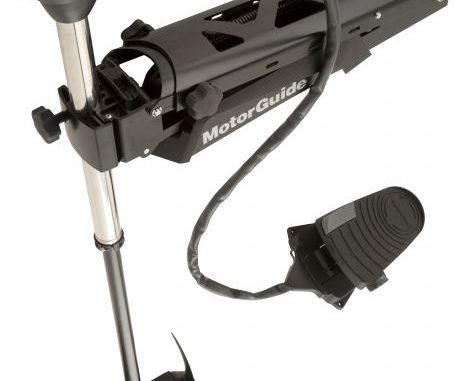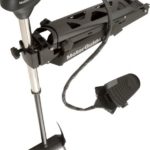
One of fishing’s truths is that more casts mean more fish in the boat. And anything that eliminates distractions and saves time helps you make more casts and lets you pay more attention to your fishing.
Minn Kota’s new Ulterra motor was designed to do just exactly this.
It starts by deploying itself at the touch of a button as you approach a fishing spot. This gives you time for at least two extra casts and, if your hair is a bit grayer than it used to be, it also saves your back for stand-up casting, and fighting and landing fish.
Once the motor is in the water, Ulterra’s Power Trim feature can raise and lower the motor’s running depth from handheld remote controls, the screens of select Humminbird units and from the motor’s foot pedal. Gone is the need to loosen a thumb screw on the shaft’s running depth clamp, slide the motor to the desired running depth and retighten the clamp (you can make three extra casts instead).
Ulterra’s power trim slides the motor shaft straight up and down in its steering collar.
Whoa! Was that a swirl behind your lure? Press the Spot-Lock button to electronically anchor your boat and make a few more casts. You can try another color or a different type of lure withoug worrying about the boat drifting off.
Spot-Lock will hold it within about 5 feet of where you pressed the electronic anchor button: Just concentrate on catching that fish.
Spot-Lock is also a big help when landing and unhooking fish. The motor fights the wind and current to keep your boat from being pushed into shore or toward dangerous obstacles while you wrestle the hooks out of that lunker’s jaw. Then, your boat is still in position to make another cast to that same spot.
When you start fishing a good-looking stretch of water, you can turn on the motor’s track-recording feature. Then, if the stretch is as good as it looked, you can tell the motor to automatically pull you up or down it again.
You can even save the track and repeat it automatically on future fishing trips.
A cruise-control function lets you set and adjust your boat’s constant fishing speed in tenths of a mile per hour.
This autopilot capability can also steer a compass direction automatically or, if following a fixed straight line would work better, it can throw out a straight-line of GPS waypoints in your chosen direction and then follow them.
Ulterra’s i-Pilot Link can even talk to select Humminbird GPS navigation units and follow depth contour lines on LakeMaster on-screen maps.
You can interrupt cruise control by pressing the Spot-Lock button to stop and fish each spot you deem worthy of a few more casts, and then resume running the track.
Inshore flats fishermen will be happy to know that Riptide saltwater versions of these motors are also available. Imagine standing on your platform and running the boat from a remote control hung around your neck.
Maybe you think an electric trolling motor won’t work for you because your bow sits too high off the water and any wave action at all would lift the motor high enough to cavitate.
Well, Minn Kota just announced a 72-inch shaft option for some fresh and saltwater versions of the Ulterra and Terrova motor lines. That’s a foot more shaft length than the previous 60-inch maximum.
Minn Kota Ulterra motors will be available this fall priced between $1,969.99 and $2,549.99; models include 80-pound thrust with 54- or 60-inch shafts and 112-pound thrust with 60- and 72-inch shafts.
The Ulterras will all come with i-Pilot GPS functionality.
For more information, visit minnkotamotors.com.
Let’s say you’re an angler who doesn’t even want electric steering pulling amps from his batteries, let alone an automatic stow and deploy system; you want to reserve every bit of battery power for turning the motor’s prop as long as possible on those windy fishing days.
You also like cable steering’s cutting-horse maneuverability when breezing through stump fields, clumps of heavy weeds and other obstructions.
So, what’s new for cable-steered motor fans? Motorguide’s new X5 offers a list of real-world improvements that put it at the top of the list.
The first thing you’ll notice about this motor is its new look. The mount is built wide for stability and has a snap-back breakaway mechanism for added shaft protection. The bracket is aircraft-grade aluminum to add strength, reduce weight and prevent rust and corrosion. Tight-fitting composite bushings in key wear points reduce noise and should ensure long life.
Speaking of noise, the X5 was designed with input from MotorGuide pro anglers, and being quiet was a continuing theme at roundtable discussions. A composite locking pin makes a quiet, tight fit with the mount (no more “clack, clack” as you pull and release the rope), and the slippery composite material makes the motor easier to stow and deploy.
Precision bearing assemblies and a locking collar eliminate shaft clicking, and polymer shock-absorbing washers at key pivot points should help reduce noise.
The next thing you’ll notice is the X5’s unusual shaft. Like other cable-steered motors it has a two-piece shaft — a large outer shaft on top gripped by the mount and a smaller inner shaft below that turns inside the outer shaft and supports the motor’s drive unit.
On the X5, the oversized upper shaft column is made of stainless steel, while the thick-walled lower shaft is made of composite material and has a lifetime guarantee against breakage. The lower shaft’s composite material should also add a bit of flex as it saves on weight.
Pros who have tested the X5 say the motor’s variable ratio steering completely changes steering feel. An elliptical cam delivers two distinct steering actions. When pointed straight ahead and steered to about 15 degrees right or left of center, the pedal exhibits precise steering control that allows very small corrections to either side.
You also don’t have to fight steering torque in the form of pedal feedback, and this makes a huge difference. The rodeo-class, steering-torque pedal lift common with powerful cable-steered motors is gone.
Beyond the precise steering zone, you have normal steering to either side that allows faster, right-angle turns and reverses when you need them. When turning slightly left or right from straight ahead, the elliptical cam provides that deliberate and precise steering by turning the motor at a slower rate. As the motor turns toward 90 degrees left or right the steering ratio changes to turn the motor at a faster rate.
The elliptical cam causes the motor to turn at this variable rate even when foot pressure is uniformly applied.
MotorGuide says the X5’s Digital Power Management feature also helps you fish longer by extending motor running time up to five times longer on a battery charge. It also keeps the motor cooler, which reduces wear and tear on motor components and should lengthen its service life.
X5 motors will be available with three shaft lengths (45, 50 and 60 inches) and four thrust levels (55, 70, 80 and 105 pounds) at dealers this fall.
Suggested retail prices range from $789.99 to $1,309.99.
Visit motorguide.com for more information.




